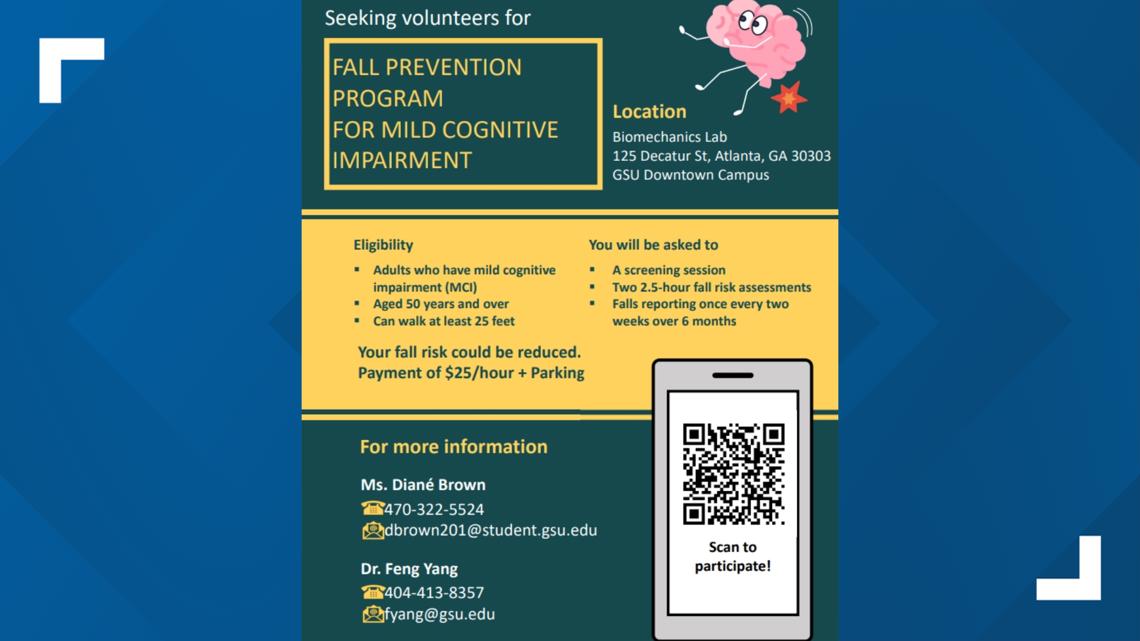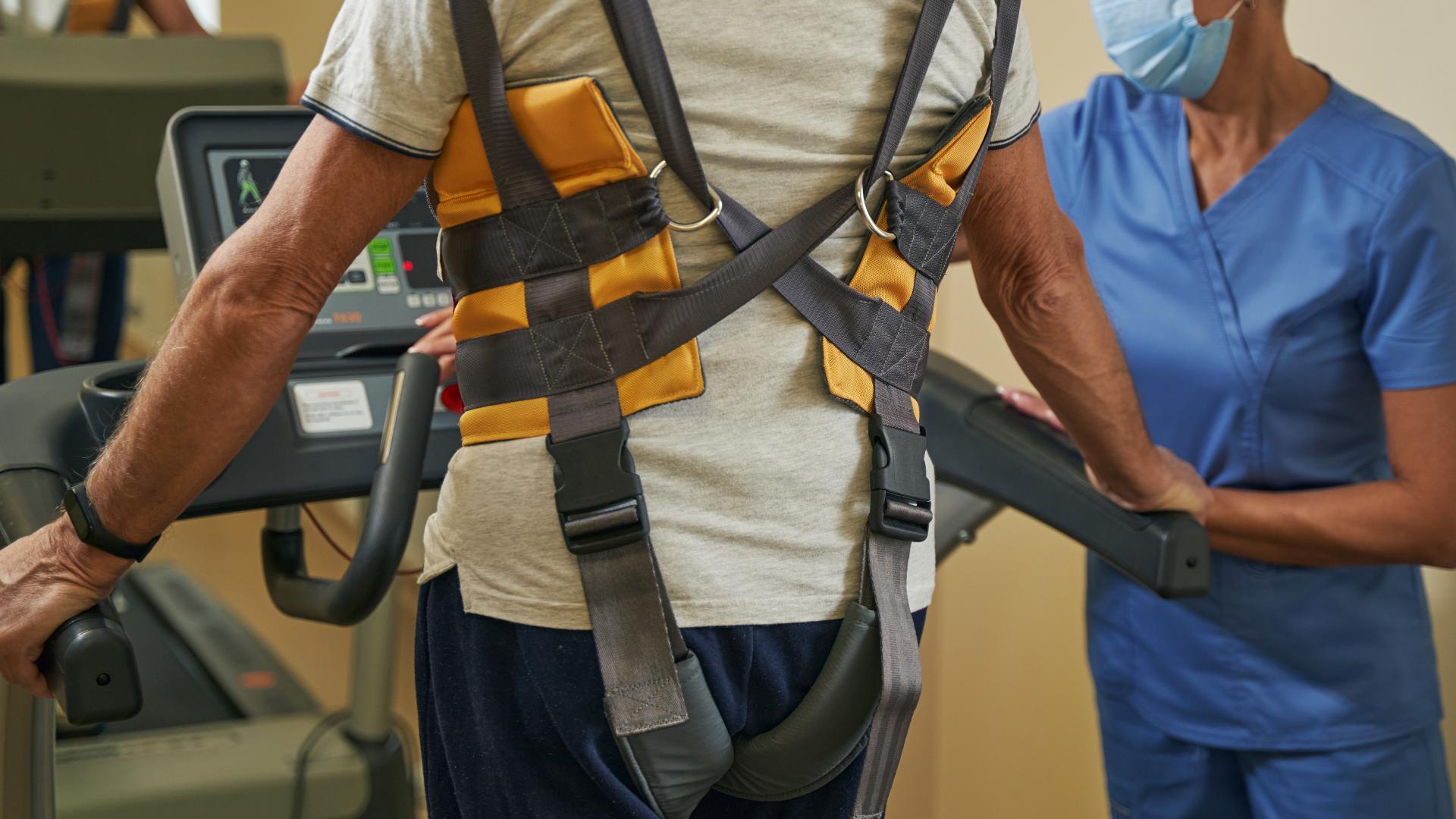ATLANTA — It’s normal to trip and fall every once in a while, but for people in the beginning stages of dementia, falling becomes dangerous and costly -- both to families and the healthcare system.
A researcher at Georgia State University has devised a creative way to keep people in cognitive decline on their feet: A new study uses a specialized treadmill to retrain the brain just by tripping. It’s called perturbation training.
Hooked up to a harness from a pulley system anchored above so the patient never actually falls, a person will stand on the treadmill as the belt shifts backward at random intervals -- knocking the person off-balance.
The person standing on the treadmill can move their feet and brace however they need to stay upright, but if the movement knocks the person off-balance completely, they fall only a few inches before the harness catches them, keeping them upright.
Dr. Feng Yang leads the research study at GSU from an old 1996 Olympics training room that was converted into a Biomechanics Lab.
Dr. Yang said even brains in cognitive decline can learn new skills.
“There is something called neuroplasticity. That means the brain has the capability to learn new skills," he said. "We were thinking if we can force them to fall, then the brain will re-experience the falling experience. It can help the brain to regain or relearn the skills, which are lost or damaged to the brain."
Dr. Yang has been studying this concept for more than 20 years. His previous research studies in people with Multiple Sclerosis showed encouraging results.
Now, thanks to funding from the Alzheimer’s Association and the National Institutes of Health, Dr. Yang is running two separate research studies on people with Mild Cognitive Impairment, the beginning stages of dementia.
Study participants come to the lab twice over the course of three months. The first visit is for the perturbation training on the treadmill. The second visit measures how much the brain learned from the first session.
Dr. Yang said it only takes one session on the treadmill for the brain to acquire new skills it can put to good use in the real world.
“We don’t need to go three months or eight weeks. It’s just one session. We hope with people with MCI and people with Alzheimer’s disease, we can use this type of training as something like a vaccine to help them reduce their fall risk,” he said.
The first visit to the biomechanics lab includes cognitive testing and a series of tests that measure bone density and mobility before the patient gets hooked up to the treadmill. Each of those steps requires giving and receiving some instructions. However, once the participant is hooked up to the treadmill, the body takes over on instinct. The researchers don’t have to give, nor does the participant need to process instructions, a task that can become quite difficult for people with cognitive impairment.
Dr. Yang said that’s one of the biggest benefits of this type of training. The brain learns the skill on its own.
“That’s one of the advantages. We don’t need to tell the trainees what to do. Everything will happen automatically in the brain. That’s why we were thinking this type of training is even more beneficial to people with cognitive impairment, because for those individuals, they may not be able to understand the instructions,” he said.


According to the National Institutes of Health, about 30% of people over 65 fall each year, often resulting in serious injuries and expensive care. The risk goes up to 70% for people with cognitive impairment, like Alzheimer’s disease. In 2015, the direct cost related to falls was around $50 billion. As the population ages and a growing number of people face cognitive impairment, that number will likely increase.
Donna Bruce, an agile 62-year-old woman, joined the study for this reason. Both her parents had Alzheimer's disease, and so she wanted to take control of her future.
“If you fall, it could devastate you to the point you become immobile. I’m always wanting to do whatever I can to remain in my home,” Bruce said.
The first few times the treadmill jerked backward, Bruce was caught off guard and grasped at the harness for stability as her feet started to slip out from under her.
After each “fall,” the researchers recalibrated the treadmill and reset markers on Bruce’s body that correspond to infrared cameras mounted around the lab. The cameras captured her movement through software on a computer that appears as tiny green dots in the shape of a human.
At random, the treadmill belt will either move or stay still. After a while, Bruce started to brace her feet and stabilize herself.
Dr. Yang said the next time Bruce experiences a fall or near-fall in real life, her brain will be better prepared to handle it.
“The interesting thing is the new motor skills will become permanent. Next time, if the person experiences something similar to the situation we trained in the lab, the brain will automatically pick the new motor skills without any consideration,” he said.
The training also conquers another hurdle: fear of falling.
“Once [a person] develops the fear of falling, they will restrict their movement or their social interaction. As a result of that, their physical condition could keep declining. That would just make a downward cycle. Eventually, it will increase their fall risk further,” Dr. Yang said.
Dr. Yang is still recruiting participants for his studies.
Bruce said she’s glad she did it.
“If you are experiencing some cognitive impairment, it could help keep you safe,” she said. “If you’re interested in remaining in your home, I encourage you to participate in a study such as this so you can get the information and knowledge to keep you safe and healthy.”

